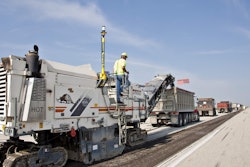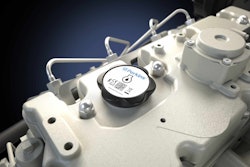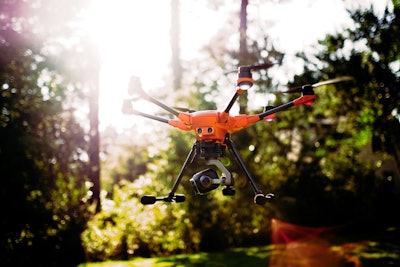 The Yuneec H520 in flight. Photos: Wayne Grayson/Equipment World
The Yuneec H520 in flight. Photos: Wayne Grayson/Equipment WorldIt doesn’t take long to figure out that Yuneec’s H520 is more than your average hobbyist drone.
Even a quick glance at the aircraft reveals signs of the H520’s intent for serious work: a six-rotor design, retractable landing gear and high-vis orange paint job. Look a bit closer and you’ll spot a serious camera too: Yuneec offers a 4K camera with this drone that packs the largest image sensor available on drones of this size class.
The H520 marks the first entry for Yuneec, a Chinese company that manufactures all sorts of electric vehicles and aircraft, into the commercial drone market. Founded in 1999 as a model aircraft company, Yuneec Electric Aviation quickly moved into producing small, electric-powered aircraft that are basically one- and two-person powered hang gliders, according to the company’s Wikipedia page.
After the company received a $60 million infusion of cash from Intel in 2015 it began making drones. Since then it has enjoyed some success, with positive reviews of its consumer drones as it attempts to eat away at the market share of fellow Chinese company and the dominant player in drones, DJI.
And while drones have quickly become as ubiquitous a consumer gadget as camcorders once were, the real future of this technology is on the commercial side. One market analysis forecasts the commercial drone market to grow to $17 billion by 2024, and though the prominent commercial application in pop culture is Amazon or UPS package delivery, more and more jobsites are adopting the technology as well.
Yuneec’s rival DJI has a well-established portfolio of aircraft on the industrial side. In fact, DJI announced earlier this year the single largest order of commercial drones in its history. The buyer? Construction equipment maker Komatsu, which ordered 1,000 DJI drones running a machine vision software produced by U.S. startup Skycatch.
But enough about DJI. We’re here to talk about Yuneec, which was kind enough to send me an H520 Mega Bundle to fly and review. Here’s what I found out in the several months I’ve been using the drone and why I think the H520 should be on every construction industry technology manager’s shortlist of aircraft to consider.
The aircraft
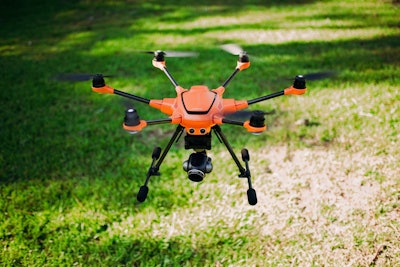
As noted before, the Yuneec H520 is a six-rotor drone designed specifically for commercial applications including construction, inspections, surveying and search and rescue. Yuneec’s Ryan Kephart says that due to its industrial chops, the drone is a bit larger than most of Yuneec’s models, but it’s also 40 percent quieter. “You can actually fly this drone on a jobsite and not annoy everybody,” Kephart said, referring to the distinctive and loud whirring that many drones produce.
Thanks to the drone’s heft and new flight controls system, it can withstand winds up to 30 miles per hour. I took the H520 out on several windy days and was impressed by how gusts of wind never seemed budge the aircraft more than a few inches in any direction. And even in spots where you might notice a gust cause little movement in the drone’s position during flight, the combination of the flight control and the camera stabilization makes any kind of movement caused by wind almost impossible to notice while reviewing video footage later.
The flight motors on the H520 are also more efficient than past Yuneec models as well, allowing for 28-30-minute flight times per battery.
Speaking of batteries, the H520’s are hot swappable, allowing the drone to return back to its launch point once the battery has nearly run down and then resume its mission after a battery swap without any loss of memory or data in the process. Kephart says the H520 can handle survey missions with up to 500 waypoints. If you’re on waypoint 200 when a battery runs out, the drone will return home, allow you to swap a battery and resume on waypoint 201 as if there were no interruption at all.
The same goes for the drone’s cameras as well. “If you’re doing an inspection and you need to find a possible heat loss, you can equip the thermal camera and identify that key area. But if then you find out that the thermal camera isn’t bringing in enough detail in low light, you can swap in the E90 camera and get a full resolution picture of the area,” Kephart says.


Here’s what was included in the H520 Mega Bundle Yuneec sent along for testing:
- H520
- ST16 remote control with Intel-powered Android operating system and a 7-inch display
- E90 camera
- E50 camera
- Pelican case
- Custom foam insert for the case that cradles the H520 and provides inserts for the batteries and other equipment
- Lume cubes – Small cubes that can be attached to the drone whenever you need extra lighting around an inspection area. “Think of them as a mobile spotlight or fill light,” Kephart says.
- Mount set
- Hoodman sunshade and a plastic sunshade for seeing the ST16’s display in direct sunlight
ST16 remote control
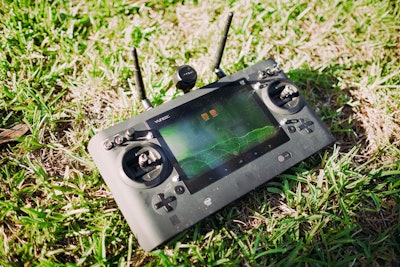
If the size and look of the H520 doesn’t drive home the fact that this drone is intended for serious industrial applications, its remote control definitely will.
With the size of a desktop keyboard and considerable heft, the ST16 gives you control of the H520 in just about every sense of the word. Kephart says this controller is more powerful than the controllers offered on Yuneec’s consumer-focused aircraft, and features more powerful radio and WiFi signals along with a super bright touch display and a USB port for connecting third-party devices. It can even charge your smartphone.
For manual control of the aircraft, the ST16 has two joysticks that deliver an impressive amount of precise and sensitive control over the H520’s movements. Though manual drone piloting can be a bit daunting to those who are inexperienced, especially with an aircraft as professional grade as this one, the joysticks on the ST16 provide a feel that is extremely reassuring. The sticks have a degree of precision that make you feel as if you’re in total control rather than fearing you’re about to launch this multi-thousand dollar aircraft into the next county.
If you’re more interested in autonomy, that’s where the ST16’s 7-inch touch display comes in.
This 7-inch embedded tablet runs on Android and is powered by an Intel processor to provide a bit more power for the heavier processing tasks that flight planning calls for. Since it does use a desktop-class processor rather than the mobile ARM processors found in smartphones and tablets, the ST16 also has a fan to provide cooling to the Intel chip.
The tablet runs Yuneec’s DataPilot mission planning software, which we’ll get into in more detail below. With it, you can map out and launch autonomous drone flights all from the tablet.
Battery life on the ST16 is only two hours, but Yuneec does offer secondary batteries for swapping in should your job exceed the ST16’s battery life.
DataPilot
Another major feature to the H520 is that it comes bundled with built-in mission planning. As Kephart noted during our briefing, most drones require you to purchase this type of software separately. “With Yuneec, you’re getting that software and that ability right out of the box,” Kephart says. “The survey missions are simple to set up and easy to use.”
Beyond being easy to use, DataPilot gives you a lot of control over the details of a planned flight. The software can plan flights with up to 500 waypoints. And as the H520 progresses through the flight, each waypoint can be programmed to change the behavior of the drone. For instance, waypoints can be used to trigger flight changes such as camera orientation or behavior, flight speed and having the drone hover over a particular position.
 The E90 4K camera.
The E90 4K camera.As for the camera commands, here are the options you can select from for each waypoint:
- Take a photo, stop taking photos
- Take Photos on time-lapse
- Take photos on distance to waypoint (such as every 5 feet)
- Stop taking photos
- Start/stop recording video
- Gimble positioning
In other words, while delivering easy to use autonomy, DataPilot still manages to give you a considerable amount of control over the H520 in the process.
And when planning a flight, DataPilot displays everything you might need to know about fitting the flight into your day by figuring out how many batteries the flight will require, the time it will take, the distance the aircraft will cover, and more.
DataPilot comes loaded up by default on the ST16 controller’s tablet (if you already use another mission planning program, such as Pix4D, you can also load that program onto the controller, Kephart says), but is also available on desktop computers if you prefer planning on a larger screen. And because the ST16 has a micro SD card slot, moving planned flights from the desktop to the drone is as easy as copying them to the SD card and popping it into the controller.
Flight impressions
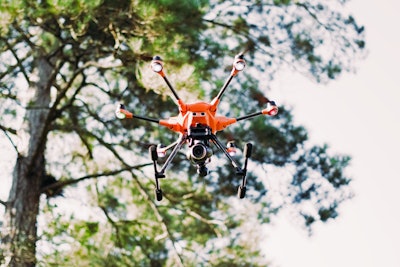
When it comes to piloting the H520, the aircraft presents a bit of a paradox. The drone’s large size, premium capabilities and imposing remote control would give any new drone operator pause. However, once you actually get your hands on the controller, piloting the H520 is actually very easy thanks to the very forgiving flight system that Yuneec has implemented here.
While you can do everything manually with the H520, you don’t have to. In fact, Yuneec gives you a lot of good reasons to lean on the flight control even if you’re a seasoned operator.
For starters, launching this bird is as easy as pressing up on the left control stick. But once you launch manually, the drone is placed into manual flight mode and you’re essentially fending for yourself in many ways. You’ll have to pay attention to wind gusts and direction and be careful not to get to close to structures and impediments like trees.
But if you launch it in auto mode, which is done with the tap of a button on the controller’s built-in tablet, the drone takes off, hovers at 9 meters and awaits your instruction. All the while it takes care of monitoring gusts and obstacles while essentially letting you tell it where to go. It’s a comforting blend of automation and manual control that allows even newbies feel comfortable flying the H520.
Outside of very specific situations, I couldn’t think of a great reason why the H520 would need to operate outside of this auto positioning mode as it lets the operator focus more on the task at hand rather than keeping the drone in the air.
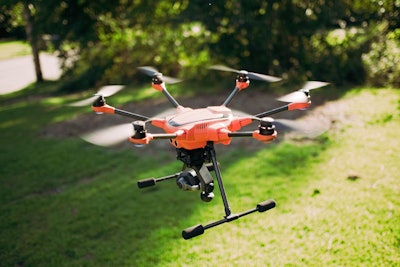
For example, for the photos I took of the drone in this article, I initiated an auto take off and the drone hovered completely still exactly where I placed it while I took the shots. There were a few gentle gusts of wind, but the drone never left the spot where I placed it.
This is especially useful when using the drone for inspections. I ran a few test missions sending the drone to areas of my house that a contractor or home inspector might want to get a closer look at without climbing a ladder. The combination of the close zoom that the E50 camera provides and the drone’s ability to hover in one spot makes easy work of this type of application.
And when it comes to surveying and waypoint missions, now we’re talking about pure automation, and the H520 and Yuneec’s DataPilot software make planning these types of missions extremely simple.
We discussed waypoint missions in the DataPilot section earlier in this review. Survey missions are even easier. Inside DataPilot, you’re shown a map of your location. From there, you simply stretch a green outline over the area on the map you want surveyed. The software, either running on your computer or on the drone’s controller, then figures out how to fly the route while you enter in how high you want the mission flown, among other customizable details.
With the tap of a button, the mission plan is uploaded into the drone and you’re able to start with a swipe on the tablet. The H520 then takes off, flies the mission and then lands. Like I said, easy.
To illustrate just how easy, here is a video showing the process of connecting the drone to the ST16 remote control and launching the H520 into a mission that I had pre-planned on the tablet. The whole thing takes less than 1 minute to do. (And I even screw up and exit to the home screen in the middle.)
Sample images
The following are still images and a video captured with the H520. (The video, originally shot in 4K, has been downsampled to 1080p for better performance.)


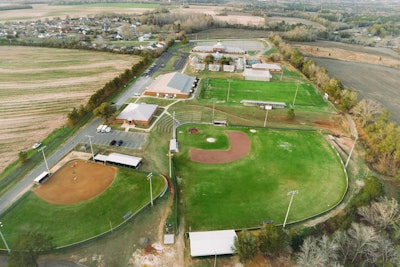
Conclusion
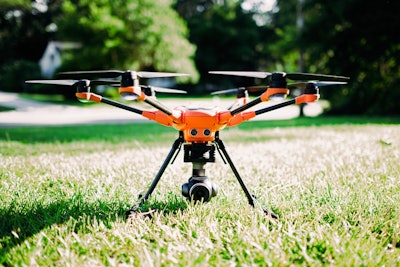
Though you can find a good drone for as little as $500 these days, you won’t find any at that price point with the performance, durability and intuitive design that Yuneec has given the H520. This is a serious, commercial drone built for rugged work environments and boasting a lot of impressive technology. And it has the price point to match, starting at $2,000 for the H520 only and going up to $4,700 for a well-equipped bundle that includes a thermal imaging camera.
It’s worth noting, however, that many commercial drones have much higher price tags and don’t offer nearly the level of approachability of the H520.
In my several months operating this aircraft, I’ve found that any business that invests in the H520 will be getting their money’s worth. There’s a level of polish to this drone that makes it a joy to operate, and a level of design that will place confidence behind flight in just about any conditions.




